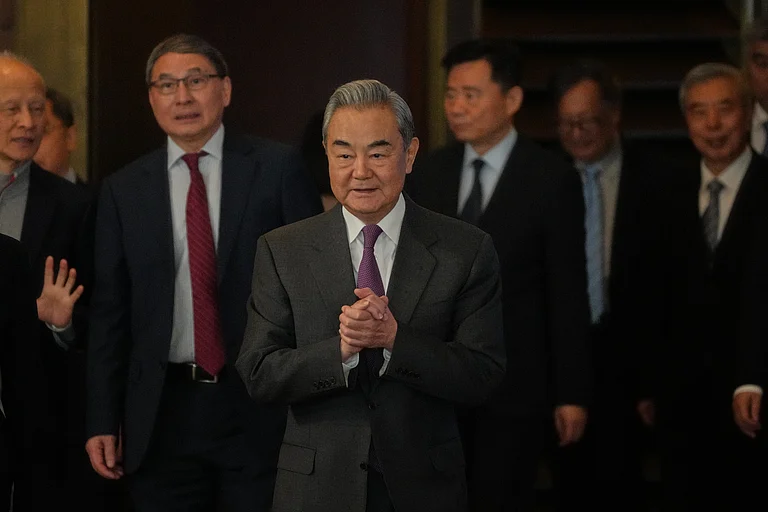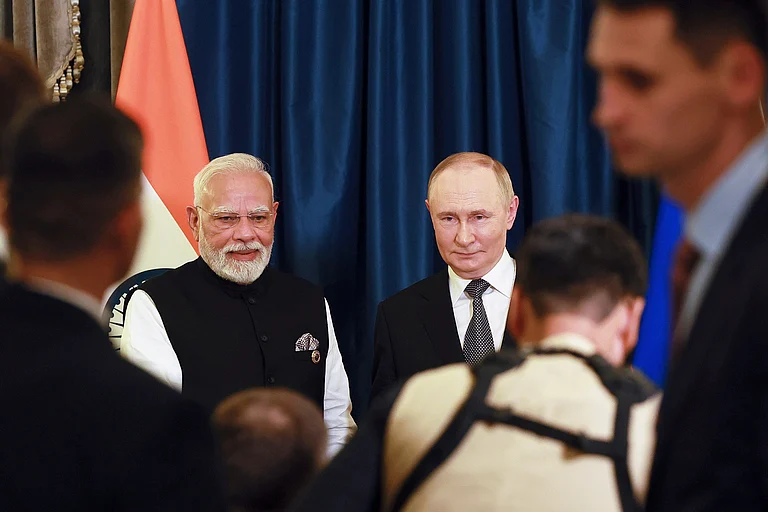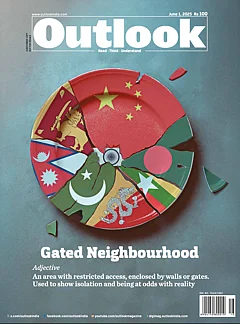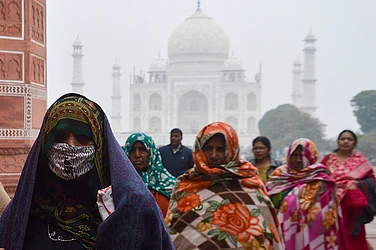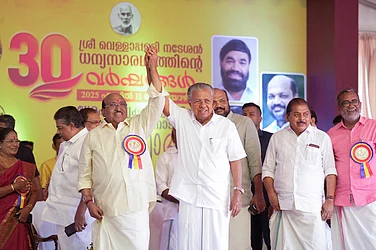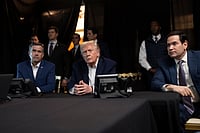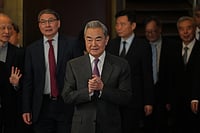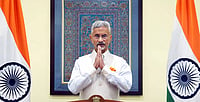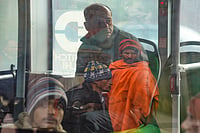When US President Donald Trump claimed credit for persuading India and Pakistan to “stop fighting” and threatened to end trade with both countries if they did not fall in line, not once but twice in Washington and in Riyadh, it wasn’t just the bravado that caught New Delhi off guard—it was the framing.
“I said, come on, we’re going to do a lot of trade with you guys. Let’s stop it. Let’s stop it. If you stop it, we’ll do a trade. If you don’t stop it, we’re not going to do any trade,” Trump told reporters at the White House. “And all of a sudden they said, ‘I think we’re going to stop,’” he added, according to reports in the American media. He admitted there were other reasons too, “... but trade is a big one.” Pakistan’s leaders praised the US for the ceasefire and thanked Trump profusely. India was not amused.
Once again, India was being bracketed with Pakistan, a comparison odious to New Delhi and something on which it had spent diplomatic capital for over two decades to overcome. Now when all seemed to go swimmingly well for India, Trump threw cold water on this assumption. For Indian policymakers, the statement was more than a diplomatic faux pas—it was a symptom of a deeper problem.
Questions came thick and fast from analysts. Where had Indian foreign policy gone wrong? Is India back to square one, being bracketed with Pakistan? What about India’s comprehensive and global partnership with the US? European partners, as well as leaders in the Middle East and the Global South, called for quick de-escalation. None of this was of use when push came to shove.
“India has received understanding and sympathy for the Pahalgam terror strike. However, Operation Sindoor is often seen as an India-Pakistan issue over Kashmir,” says Gurjit Singh, a former ambassador to Germany, explaining the international community’s attitude. “We have to enhance efforts to get our point of view accepted. We need support to get The Resistance Front (TRF) under the UNSC 1267 committee. We need to activate our counter-terrorism dialogue with strategic partners,” he adds.
Despite Prime Minister Narendra Modi’s huge international outreach, his constant travels around the world, and his warm embrace of global leaders—from Trump, French President Emmanuel Macron to Israeli Prime Minister Benjamin Netanyahu and Russian President Vladimir Putin—personal relations did not come to the fore during the current crisis. Everyone condemned the Pahalgam attack, but did not point fingers at Pakistan. A far cry from the time when former US President Bill Clinton wagged a finger at President Pervez Musharraf during a visit to Islamabad in March 2000.
“The crisis was an act of terrorism in which innocent civilians were killed. This is the issue on which the diplomatic response has to be judged. Not India-Pakistan relations,” says Asoke Mukerji, India’s former ambassador to the UN. “If we keep this focus on countering terrorism, our hope should be that the US will follow through on its solidarity with India by rolling up Pakistan’s terror infrastructure, including funding, and imposing sanctions if Pakistan does not comply,” he says. Mukerji’s response echoes the general feeling in India and people’s disappointment at Trump equating India and Pakistan.
With unpredictable Trump, nothing can be taken for granted. He blows hot and cold. He is pragmatic and can change his stand if it does not suit his purpose.
Many Indians see the US action as a betrayal. After all, the Modi government had gone out of its way to woo Trump. Public sentiment against Pakistan after the Pahalgam massacre is at an all-time high. So much so that Indian tourists are refusing to go to Türkiye and Azerbaijan for siding with Pakistan during the current crisis.
Old-timers remember America’s past fast friendship with Pakistan, and how during the Bangladesh war, it had sided decisively with Islamabad. Indira Gandhi, as prime minister, had visited Washington and European capitals to brief them on the atrocities of the Pakistan Army in the Eastern wing of the country. It was to no avail. She finally signed a friendship treaty with Russia before sending the Indian Army to help the Mukti Bahini and carve out an independent Bangladesh. However, that was decades ago.
Today, despite the hiccup in ties—thanks to Trump’s penchant for shooting from the hip, and claiming credit for everything—Delhi and Washington will not allow this to torpedo relations. Both countries share strategic concerns about the rise of China. Washington’s current warmth and outreach to India has much to do with countering China’s growing political and economic power that in years to come could challenge America’s superpower status. For India, friendship with the US is an insurance against China in Asia. At the moment, India is peeved, but in a couple of weeks, the US administration will make efforts to placate India. Both sides will then need to work to repair bilateral relations. The process will take a couple of months till a trade deal is finalised. That could happen by the end of the year, according to people involved with the negotiations. America is also eyeing India’s huge market while India is looking towards the US for high-tech collaboration, factors that will continue to be the driving force in keeping the relations intact. It will take time for India-US ties to get back to the stage it was before the current crisis.
“I think the underlying relationship is strong, but President Trump is very influenced by evolving events and makes policies on the fly and in the short-term that belie the strength of the relationship. India is an important partner in the region—the US would like her to help balance against China—so it would be against US geostrategic interests to have the relationship flounder,” says Joanna Spear of Washington’s Elliott School of International Affairs.
India Pushback
India did not take Trump head-on. Instead, it concentrated on pushing back the American narrative for its domestic audience. India insists that Pakistan opted for the ceasefire after its air bases across the country were hit and damaged. The Ministry of External Affairs (MEA), while confirming that American officials worked the phone lines, categorically denied that trade was mentioned during the talks. Allowing no scope for third-party intervention in India-Pakistan issues, External Affairs Minister S. Jaishankar declared this week: “So, let me take this opportunity to spell out our position. One, where Pakistan is concerned, our relations, our dealings with them will be bilateral, and strictly bilateral. That is the national consensus for many years.” Pakistan has always tried to internationalise its dispute with India and get a third country to broker peace.
India insists that Pakistan opted for the ceasefire after its air bases across the country were hit and damaged.
When Prime Minister Modi came to power in 2014, he initiated his government’s “neighbourhood first” policy. Leaders of all South Asian countries, including Pakistan’s then Prime Minister Nawaz Sharif, were invited to his inauguration. On Christmas Day 2015, Modi took the unprecedented step of an unscheduled stopover at Lahore to greet Sharif on his birthday—he was on his way back from an official visit to Afghanistan. There was hope of peace in the air. But with the terror attack on the Pathankot Air Force Station on January 2, 2016, all efforts at peace-making flew out of the window. After that, things went steadily downhill with terror strikes in 2016 and 2019. Modi’s trust was completely broken and India framed its new policy of “terror and talks can’t go together”. The scrapping of Kashmir’s special status further eroded ties. The April 22 Pahalgam terror attack was the final blow to any hope of improving relations. New Delhi repeatedly said that Operation Sindoor was on pause, meaning any misadventure by Pakistan-based terrorists would be met with force.
The rest of the world views the issue with a different prism. “Kashmir remains one of the most dangerous flashpoints in the world. It is one of the most heavily militarised regions on the planet, and its proximity to China adds another layer of strategic risk. On top of that, the adjacent Ladakh region—where India and China have their own contested border—further complicates the picture. Clashes there, like those we have seen in recent years, show how quickly localised tensions can escalate,” says Ali Mammadov of George Mason University.
While India rises on the global stage, its footing closer home remains uncertain. Its relations with its neighbours have seen several ups and downs. Modi was immensely popular in Nepal when he first visited the country in August 2014. But that was short-lived, after the constitutional standoff and India’s blockade of the country. Bangladesh, India’s closest ally till Sheikh Hasina’s ouster, is now almost a hostile neighbour. Maldives and Sri Lanka have both seen fluctuations in bilateral ties. China’s growing economic power and its presence in India’s neighbourhood have given smaller countries a choice that was earlier not available.
Post-1991 Economic Reforms
Since India opened its markets to the world after the 1991 economic reforms, New Delhi’s relations with the US and the West transformed. The defeat of Communism and the breakdown of the former Soviet Union helped the country to replace the Nehruvian-era socialist mindset and the accompanying non-aligned foreign policy, which dominated the years immediately after Independence. New Delhi’s support for liberation movements across the world was also toned down. The Narasimha Rao government upgraded relations with Israel, while New Delhi’s support for the Palestinian cause was gradually diluted. India was one of the first non-Arab countries to recognise the Palestine Liberation Organization (PLO) as the sole representative of the Palestinian people. A PLO office was set up in Delhi in 1975. PLO Chief Yasser Arafat was then a close friend of India. Today, India’s support for Israel has replaced much of its earlier empathy for the Palestinian cause.
Successive Indian and US administrations have forged closer relations since the landmark civil nuclear deal was signed in 2005 by late Prime Minister Manmohan Singh and President George W. Bush. During Joe Biden’s tenure, India got a lot of leverage and was able to stand by old friend Russia during the Ukraine war, and buy oil at reduced rates despite sweeping sanctions that Washington slapped on Moscow. The Biden administration had minimal interaction with Pakistan. But with unpredictable Trump, nothing can be taken for granted. He blows hot and cold. He is pragmatic and can change his stand if it does not suit his purpose. New Delhi needs to draw some lessons from the current crisis. It is best to draw the red lines on issues of national interest even at the cost of displeasing a temperamental American president. Keeping quiet or ignoring remarks made by Trump does not help. To quote Jaishankar’s remarks on foreign policy: “So my sense for a foreign policy ahead would really be to think big, to think long, but to think smart.” India needs to think smart and concentrate on growing its economy. Economic heft counts the most in a world of flux.
This article is part of Outlook’s 1 June 2025 issue, 'Gated Neighbourhood', which examines the state of diplomacy, media, and democracy in the wake of the ceasefire. It appeared in print as 'No Brokerhood!'








